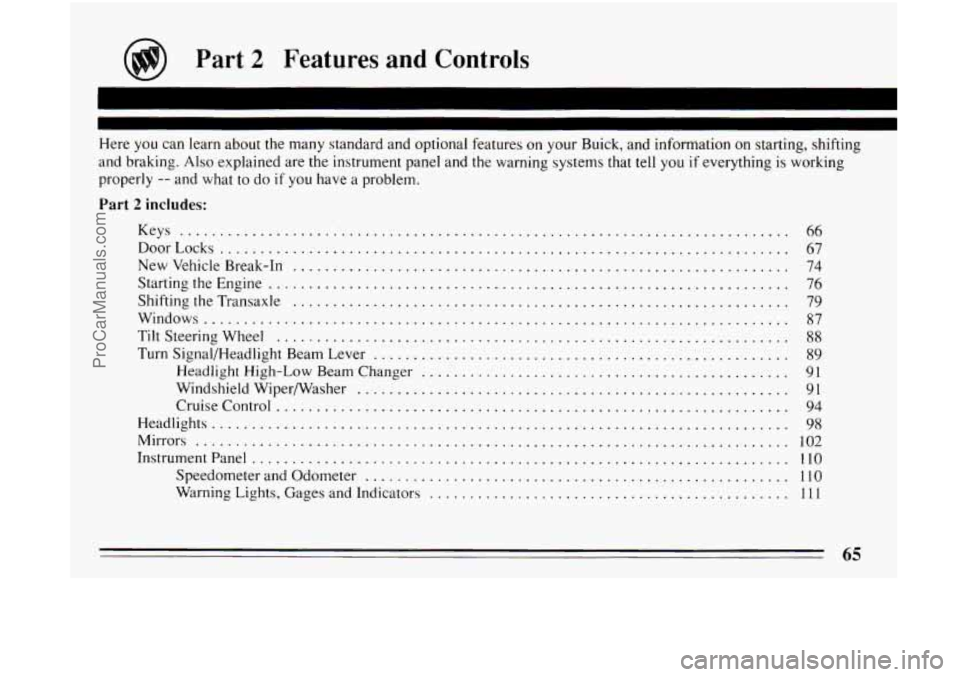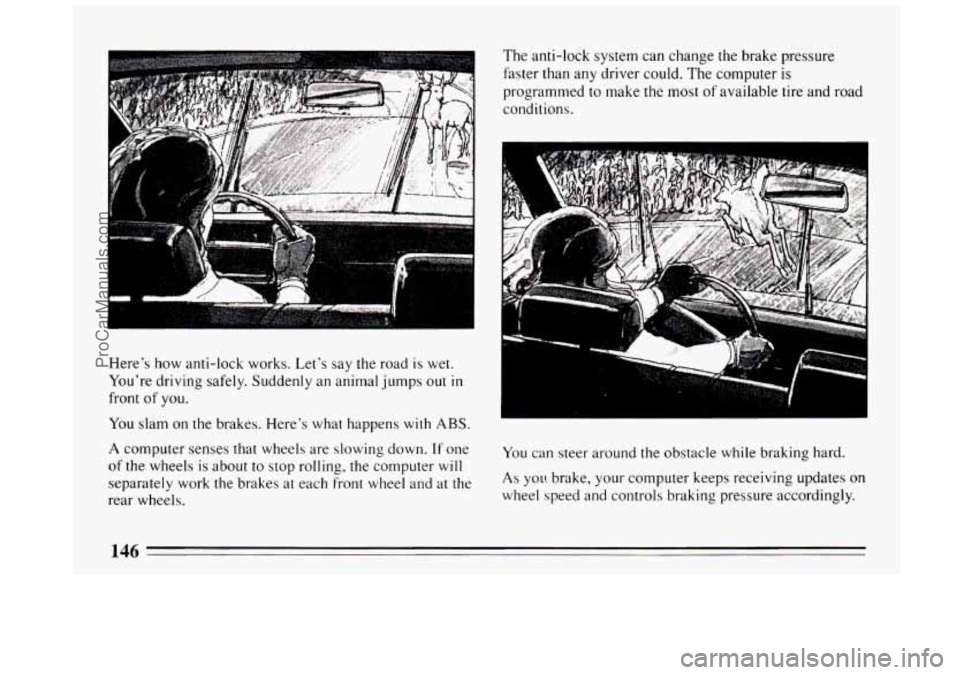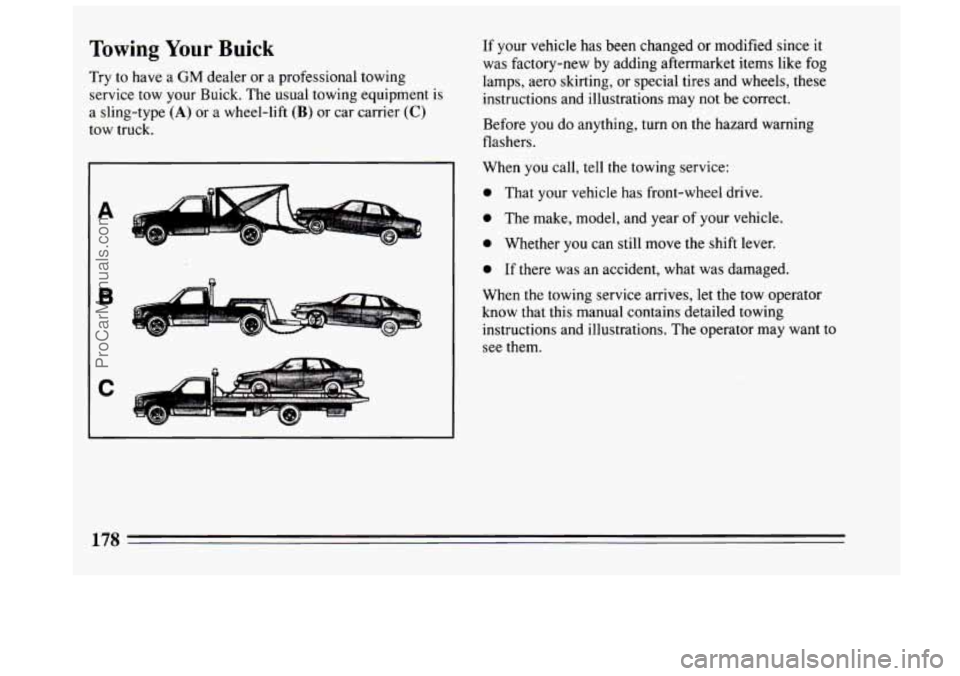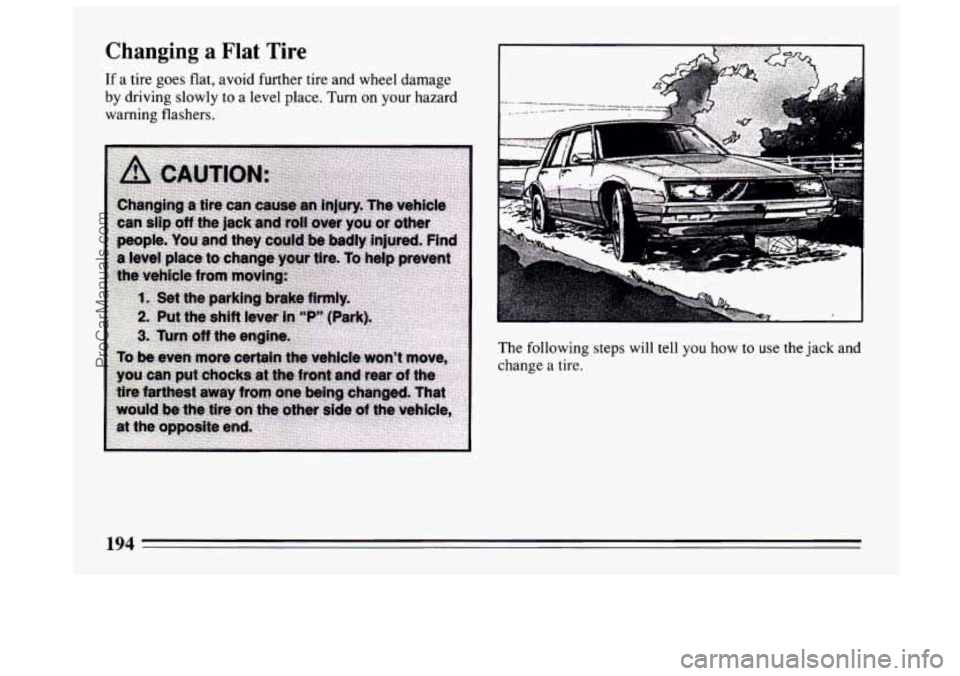change wheel BUICK CENTURY 1994 Owners Manual
[x] Cancel search | Manufacturer: BUICK, Model Year: 1994, Model line: CENTURY, Model: BUICK CENTURY 1994Pages: 308, PDF Size: 16.3 MB
Page 67 of 308

?art 2 Features and Controls
Here you can learn about the many standard and optional features on your Buick. and information on starting. shifting
and braking
. Also explained are the instrument panel and the warning systems that tell you if everything is working
properly
.. and what to do if you have a problem .
Part 2 includes:
Keys ........................................................................\
.. 66
DoorLocks .............................. ................................... 67
New Vehicle Break-In ..................... ..................................... 74
StartingtheEngine
................................................................. 76
ShiftingtheTransaxle ............................................................ 79
Windows ....................................................................... \
87
TiltSteeringWheel
................................................................ 88
Turn Signal/Headlight Beam Lever .................................................... 89
Headlight High-Low Beam Changer
.............................................. 91
Windshield Wipermasher ...................................................... 91
CruiseControl
................................................................ 94
Headlights
........................................................................\
98
Mirrors ........................................................................\
.. 102
Instrumentpanel ................................................................... 110
Speedometer and Odometer ..................................................... 110
Warning Lights . Gages and Indicators ............................................. 111
65
ProCarManuals.com
Page 148 of 308

/-
Here’s how anti-lock works. Let’s say the road is wet.
You’re driving safely. Suddenly an animal jumps out
in
front of you.
You slam on the brakes. Here’s what happens with ABS.
A computer senses that wheels are slowing down. If one
of the wheels is about to stop rolling, the computer will
separately work the brakes at each front wheel and at the
rear wheels. The
anti-lock system can change the brake pressure
faster than any driver could. The computer
is
programmed to make the most of available tire and road
conditions.
You can steer around the obstacle while braking hard.
As you brake, your computer keeps receiving updates on
wheel speed and controls braking pressure accordingly.
146
ProCarManuals.com
Page 149 of 308

Remember: Anti-lock doesn’t change the time you need
to get your foot up to the brake pedal. If you get too
close
to the vehicle in front of you, you won’t have time
to apply your brakes
if that vehicle suddenly slows or
stops. Always leave enough room up ahead to stop, even
though you have anti-lock brakes.
Steering
Power Steering
If you lose power steering assist because the engine
stops or the system is not functioning, you can steer but
it will take much more effort.
To Use Anti-Lock
Don’t pump the brakes. Just hold the brake pedal down
and let anti-lock
work for you. You may feel the system
working, or
you may notice some noise, but this is
normal. When your anti-lock system is adjusting brake
pressure to help avoid a braking skid, the
“LOW
TRACTION” light will come on. See “Anti-Lock Brake
System Active Light”
in the Index.
Braking in Emergencies
Use your anti-lock braking system when you need to.
With anti-lock, you can steer and brake at the same
time. In many emergencies, steering can help
you more
than even
the very best braking.
Steering Tips
Driving on Curves
It’s important to take curves at a reasonable speed.
A lot of the “driver lost control” accidents mentioned on
the news happen on curves. Here’s why:
Experienced driver or beginner, each of us is subject to
the same laws
of physics when driving on curves. The
traction of the tires against the road surface makes
it
possible for the vehicle to change its path when you turn
the front wheels. If there’s no traction, inertia will keep
the vehicle going
in the same direction. If you’ve ever
tried to steer
a vehicle on wet ice, you’ll understand this.
The traction
you can get in a curve depends on the
condition of your tires and the road surface, the angle at
which
the curve is banked, and your speed. While
you’re
in a curve, speed is the one factor you can
control.
147
ProCarManuals.com
Page 153 of 308

e If other cars are lined up to pass a slow vehicle, wait
your turn. But take care that someone isn’t trying to
pass you as you pull
out to pass the slow vehicle.
Remember to glance over your shoulder and check
the blind spot.
e Check your mirrors, glance over your shoulder, and
start your left lane change signal before moving out
of the right lane to pass. When
you are far enough
ahead of the passed vehicle to see
its front in your
inside mirror, activate your right lane change signal
and move back into the right lane. (Remember that
your right outside mirror is convex. The vehicle you
just passed may seem to be farther away from you
than
it really is.)
two-lane roads. Reconsider before passing the next
vehicle.
Try not to pass more than one vehicle at a time on
e Don’t overtake a slowly moving vehicle too rapidly.
Even though the brake lights are
not flashing, it may
be slowing down or starting to
turn.
If you’re being passed, make it easy for the
following driver to get ahead of you. Perhaps you
can ease a
little to the right.
Loss of Control
Let’s review what driving experts say about what
happens when the three control systems (brakes, steering
and acceleration) don’t have enough friction where the
tires meet the road to do what the driver has asked.
In any emergency, don’t give
up. Keep trying to steer
and constantly seek an escape route or area
of less
danger.
Skidding
In a skid, a driver can lose control of the vehicle.
Defensive drivers avoid most skids by taking reasonable
care suited to existing conditions, and by not
“overdriving” those Conditions. But skids are always
possible.
The three types
of skids correspond to your Buick’s
three control systems. In the braking skid your wheels
aren’t rolling. In the steering
or cornering skid, too
much speed or steering
in a curve causes tires to slip and
lose cornering force. And in the acceleration skid too
much
throttle causes the driving wheels to spin.
A cornering skid and an acceleration skid are best
handled by easing your foot off the accelerator pedal.
151
ProCarManuals.com
Page 171 of 308

Passing
You’ll need more passing distance up ahead when
you’re towing a trailer. And, because you’re a good deal
longer, you’ll need to go much farther beyond the
passed vehicle before you can return to
your lane.
Backing Up
Hold the bottom of the steering wheel with one hand.
Then, to move the trailer to the left, just move that hand
to the left.
To move the trailer to the right, move your
hand to the right. Always back up slowly and,
if
possible, have someone guide you.
Making Turns
When you’re turning with a trailer, make wider turns
than normal.
Do this so your trailer won’t strike soft
shoulders, curbs, road signs, trees, or other objects.
Avoid jerky
or sudden maneuvers. Signal well in
advance.
Turn Signals When Towing a Trailer
When you tow a trailer, your vehicle has to have a
different turn signal flasher and extra wiring. The green arrows
on your instrument panel
will flash whenever
you signal
a turn or lane change. Properly hooked up,
the trailer lights
will also flash, telling other drivers
you’re about to turn, change lanes or stop.
When towing a trailer, the green arrows on your
instrument panel
will flash for turns even if the bulbs on
the trailer are burned out. Thus, you may
think drivers
behind you are seeing your signal when they are not. It’s
important to check occasionally to be sure
the trailer
bulbs are still working.
Driving On Grades
Reduce speed and shift to a lower gear before you start
down a long or steep downgrade.
If you don’t shift
down, you might have
to use your brakes so much that
they would get hot and no longer work well.
On a long
uphill grade, shift down and reduce your
speed to around 45
mph (70 km/h) to reduce the
possibility
of engine and transaxle overheating.
If you are towing a trailer that weighs more than 1,000
pounds (450
kg) and you have an automatic transaxle
with Overdrive, you may prefer to drive in “D” instead
of Overdrive.
An overdrive transmission is required if
towing a trailer more than 1,000 pounds (450 kg).
ProCarManuals.com
Page 180 of 308

Towing Your Buick
Try to have a GM dealer or a professional towing
service tow your Buick. The usual towing equipment is
a sling-type
(A) or a wheel-lift (B) or car carrier (C)
tow truck. If
your
vehicle has been changed or modified since it
was factory-new by adding aftermarket items like fog
lamps, aero skirting, or special tires and wheels, these
instructions and illustrations may not be correct.
Before you do anything, turn on the hazard warning
flashers.
When you call, tell
the towing service:
0 That your vehicle has front-wheel drive.
0 The make, model, and year of your vehicle.
0 Whether you can still move the shift lever.
0 If there was an accident, what was damaged.
When the towing service arrives, let the tow operator
know that this manual contains detailed towing
instructions and illustrations. The operator may want
to
see them.
178
ProCarManuals.com
Page 195 of 308

10. Then replace the
pressure cap. At any
time during this
procedure if coolant
begins to flow
out of the
filler neck, reinstall the
pressure cap. Be sure
the arrows on pressure cap line up like this.
11. Check the coolant in the recovery tank. The level in
the coolant recovery tank should be at the
“HOT”
mark when the engine is hot or at the “ADD” mark
when the engine
is cold.
If a Tire Goes Flat
It’s unusual for a tire to “blow out” while you’re driving,
especially
if you maintain your tires properly. If air goes
out
of a tire, it’s much more likely to leak out slowly.
But if you should ever have a “blowout,” here are
a few
tips about what
to expect and what to do:
If a front tire fails, the flat tire will create a drag that
pulls the vehicle toward that side. Take your
foot off the
accelerator pedal and grip the steering wheel firmly.
Steer to maintain lane position, then gently brake to a
stop well out
of the traffic lane.
A rear blowout, particularly on a curve, acts much like a
skid and may require the same correction you’d use in a
skid.
In any rear blowout, remove your foot from the
accelerator pedal. Get the vehicle under control by
steering the way
you want the vehicle to go. It may be
very bumpy and noisy, but
you can still steer. Gently
brake to
a stop, well off the road if possible.
If a tire goes flat, the next section shows how to use
your jacking equipment to change a flat tire safely.
193
ProCarManuals.com
Page 196 of 308

Changing a Flat Tire
If a tire goes flat, avoid further tire and wheel damage
by driving slowly to a level place.
Turn on your hazard
warning flashers.
The following steps
will tell you how to use the jack and
change a
tire.
194
ProCarManuals.com
Page 201 of 308

Wire Wheel Cover
Removing the wire wheel
cover requires this wire
wheel key wrench.
F1 Put the flat end into the
notch and carefully pry the
small center cover
off.
Remove the theft deterrent
wheel
nut by placing the
key end
of the wire wheel
wrench over the
nut and
turning
it to the left. Pull
off the wire wheel cover.
P
Next, attach the wheel wrench to the bolt on the end of
the jack. Raise the jack a little by rotating the wheel
wrench clockwise
(to the right).
Using the wheel wrench, loosen all the wheel nuts.
Don't remove them yet.
Position the jack under the
vehicle nearest the tire to be
changed. The jack location
should be approximately
five inches
(12.7 cm) from
the wheel well.
ProCarManuals.com
Page 268 of 308

Scheduled Maintenance Services Schedule I
~
Follow Schedule I if your car is MAINLY driven under one or more of the following conditions:
0 When most trips are less than 4 miles (6 kilometers).
0 When most trips are less than 10 miles (16 kilometers) and outside temperatures remain below fr\
eezing.
0 When most trips include extended idling and/or frequent low-spee\
d operation as in stop-and-go traffic.
0 Towing a trailer.*?
0 When operating in dusty areas.
Schedule I should also be followed if the car is used for delivery service, police, taxi or other commercial applications. \
TO BE SERVICED
(See Explanation of
Scheduled Maintenance Miles (kilometers) or
Services Following Months, Whichever
Schedules I and 11) Occurs First KILOMETERS (000)
WHEN TO PERFORM MILES (000)
3
Item No.
Every30oOmi.(50@)km)or months 0 0 0 0 0 0 0 0 0 0 1. Engine oil & Filter Change
5 10 15 20 25 30 35 40 45 50 55 60 65 70 75 80
3. Tire & Wheel Rotation &
Every other oil change 0 0 0 0 0 0 0 0 2. Chassis Lubrication
every 15 ooo mi. (25 ooo km)
At 6 OOO mi. (10 000 km) and
or as necessary
4. Engine Accessory Drive
5. Cooling System Service"
Inspection
0 0 0
Belt(s)
Inspection* Every 30 OOO mi.
(50 000 km) or 24 months. 0
266
ProCarManuals.com